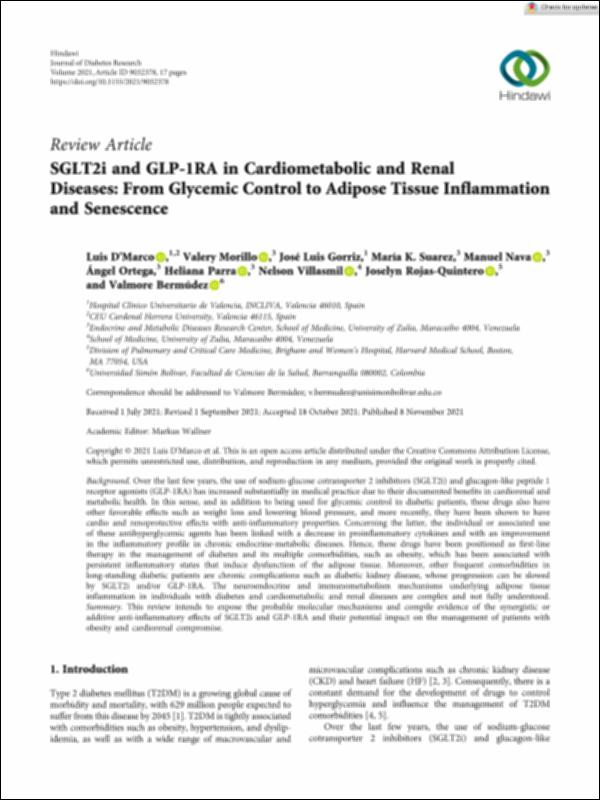Por favor, use este identificador para citar o enlazar este ítem:
http://hdl.handle.net/10637/16160SGLT2i and GLP-1RA in cardiometabolic and renal diseases: from glycemic control to adipose tissue inflammation and senescence
| Título : | SGLT2i and GLP-1RA in cardiometabolic and renal diseases: from glycemic control to adipose tissue inflammation and senescence |
| Autor : | D'Marco Gascón, Luis Gerardo Morillo, Valery Górriz, José Luis Suárez, María K. Nava, Manuel Ortega, Ángel Parra, Heliana Villasmil, Nelson Rojas Quintero, Joselyn Bermúdez, Valmore |
| Materias: | Enfermedad cardiovascular; Cardiovascular diseases; Aparato urinario; Urinary system; Enfermedad; Diseases; Metabolismo; Metabolism; Genética humana; Human genetics; Tejido adiposo; Adipose tissue; Diabetes |
| Editorial : | John Wiley & Sons |
| Citación : | D'Marco, L., Morillo, V., Gorriz, J.L., Suarez, M.K., Nava, M., Ortega, Á., Parra, H., Villasmil, N., Rojas-Quintero, J. & Bermúdez, V. (2021). SGLT2i and GLP-1RA in cardiometabolic and renal diseases: from glycemic control to adipose tissue inflammation and senescence. Journal of Diabetes Research, vol. 2021, i. 1 (jan.), art. 9032378. DOI: https://doi.org/10.1155/2021/9032378 |
| Resumen : | Background. Over the last few years, the use of sodium-glucose cotransporter 2 inhibitors (SGLT2i) and glucagon-like peptide 1 receptor agonists (GLP-1RA) has increased substantially in medical practice due to their documented benefits in cardiorenal and metabolic health. In this sense, and in addition to being used for glycemic control in diabetic patients, these drugs also have other favorable effects such as weight loss and lowering blood pressure, and more recently, they have been shown to have cardio and renoprotective effects with anti-inflammatory properties. Concerning the latter, the individual or associated use of these antihyperglycemic agents has been linked with a decrease in proinflammatory cytokines and with an improvement in the inflammatory profile in chronic endocrine-metabolic diseases. Hence, these drugs have been positioned as first-line therapy in the management of diabetes and its multiple comorbidities, such as obesity, which has been associated with persistent inflammatory states that induce dysfunction of the adipose tissue. Moreover, other frequent comorbidities in long-standing diabetic patients are chronic complications such as diabetic kidney disease, whose progression can be slowed by SGLT2i and/or GLP-1RA. The neuroendocrine and immunometabolism mechanisms underlying adipose tissue inflammation in individuals with diabetes and cardiometabolic and renal diseases are complex and not fully understood. Summary. This review intends to expose the probable molecular mechanisms and compile evidence of the synergistic or additive anti-inflammatory effects of SGLT2i and GLP-1RA and their potential impact on the management of patients with obesity and cardiorenal compromise. |
| URI : | http://hdl.handle.net/10637/16160 |
| Derechos: | http://creativecommons.org/licenses/by/4.0/deed.es Open Access |
| ISSN : | 2314-6745 2314-6753 (Electrónico) |
| Fecha de publicación : | 2021 |
| Centro : | Universidad Cardenal Herrera-CEU |
| Aparece en las colecciones: | Dpto. Medicina y Cirugía |
Los ítems de DSpace están protegidos por copyright, con todos los derechos reservados, a menos que se indique lo contrario.


